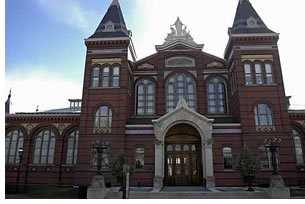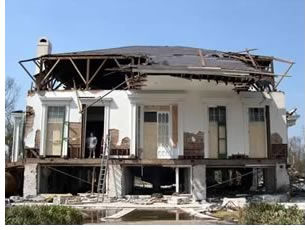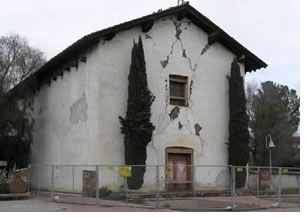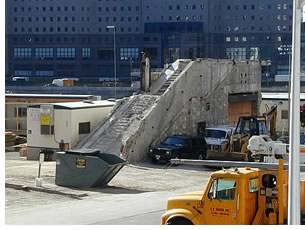

5/2006

“America’s priceless heritage is under attack from all sides, from the Gulf Coast to the nation’s capital to a site associated with America’s most tragic day,” reports the National Trust for Historic Preservation in its annual message calling attention to the country’s Most Endangered Historic Places. Among the 11 sites the group calls out in its 2006 list are the Smithsonian’s Arts and Industries Building, masterpiece of architect Adolf Cluss; the “‘Survivors’ Staircase,’” in Lower Manhattan, the only remaining above-ground fragment of the vanished Twin Towers; and the historic neighborhoods of New Orleans and the Gulf Coast of Mississippi.
Sites on the 2006 list of America’s 11 Most Endangered Historic Places are:
 Smithsonian Arts & Industries Building, Washington, D.C. The first
building expressly built as a museum on the National Mall in the nation’s
capital, the Arts & Industries Building was completed in 1881 to
receive the collections of the 1876 Centennial Exposition in Philadelphia.
With its central rotunda and polychrome exterior of red, black, tan,
and blue bricks, the building served as a dramatic exhibition space until
it was shuttered in 2004 after years of neglect and under-use.
Smithsonian Arts & Industries Building, Washington, D.C. The first
building expressly built as a museum on the National Mall in the nation’s
capital, the Arts & Industries Building was completed in 1881 to
receive the collections of the 1876 Centennial Exposition in Philadelphia.
With its central rotunda and polychrome exterior of red, black, tan,
and blue bricks, the building served as a dramatic exhibition space until
it was shuttered in 2004 after years of neglect and under-use.
(Photo © Smithsonian Institution.)
Blair Mountain Battlefield, Logan County, W. Va. Blair Mountain’s 1,600-acre Spruce Fork Ridge is the site of a 1921 armed insurrection of unionized coal miners fighting for better working conditions and an end to the oppressive control of the coal industry in southern West Virginia. Today, the ridge, a remote and serene place of hardwood forests and precipitous hillsides, is threatened by strip mining that will obliterate the site of America’s largest domestic conflict since the Civil War.
 Doo Wop Motels, Wildwood, N.J. Named after a popular 1950s singing style,
Wildwood’s Doo Wop motels are the colorful beach resorts that line
40 blocks of New Jersey shoreline. Considered the largest collection
of mid-20th century commercial resort architecture in the nation, the
motels are famous for their neon-bright colors, funky signage, and exotic
architecture of saw-toothed angles, crazy overhangs, and space-age “Jetson” ramps.
More than 100 of these iconic reminders of the recent past have already
met the wrecking ball, and more are slated for demolition.
Doo Wop Motels, Wildwood, N.J. Named after a popular 1950s singing style,
Wildwood’s Doo Wop motels are the colorful beach resorts that line
40 blocks of New Jersey shoreline. Considered the largest collection
of mid-20th century commercial resort architecture in the nation, the
motels are famous for their neon-bright colors, funky signage, and exotic
architecture of saw-toothed angles, crazy overhangs, and space-age “Jetson” ramps.
More than 100 of these iconic reminders of the recent past have already
met the wrecking ball, and more are slated for demolition.
(Lollipop Motel. Photo © Adrian Fine.)
Fort Snelling Upper Post, Hennepin County, Minn. On a large, scenic promontory overlooking the confluence of the Mississippi and Minnesota Rivers, Fort Snelling has been keeping watch over the citizens of the region since long before the formation of the Minnesota territory. While parts of the fort complex have been restored, the 141-acre Upper Post area, which contains 28 brick buildings constructed between the late 1870s and the early 1900s, have been vacant for more than three decades and stand in various states of disrepair, some with collapsed roofs and severely cracked brick walls.
 Historic Communities and Landmarks of the Mississippi
Coast. When Hurricane
Katrina hit the Gulf Coast last August, the historic communities and
landmarks of Mississippi suffered incalculable damage. For months, historic
homeowners have been entrenched in an exhausting rebuilding effort. Similarly,
numerous Mississippi landmarks including Beauvoir, the Biloxi retirement
home of Confederate President Jefferson Davis, and Pascagoula’s
La Pointe-Krebs House, believed to be the oldest standing building in
the state, were devastated by the storm and face uncertain futures nearly
one year after Katrina.
Historic Communities and Landmarks of the Mississippi
Coast. When Hurricane
Katrina hit the Gulf Coast last August, the historic communities and
landmarks of Mississippi suffered incalculable damage. For months, historic
homeowners have been entrenched in an exhausting rebuilding effort. Similarly,
numerous Mississippi landmarks including Beauvoir, the Biloxi retirement
home of Confederate President Jefferson Davis, and Pascagoula’s
La Pointe-Krebs House, believed to be the oldest standing building in
the state, were devastated by the storm and face uncertain futures nearly
one year after Katrina.
Historic Neighborhoods of New Orleans. They are the heart and soul of
the city—the modest, colorful shotgun houses, Craftsman bungalows,
and Creole cottages that line the streets of New Orleans’s Lower
9th Ward and working-class neighborhoods such as Mid-City, Holy Cross,
and South Lakeview. Now, in the wake of Hurricane Katrina’s winds
and floodwaters, hundreds of family homes are “red-tagged” for
demolition, and the future of America’s most distinctive city is
at stake.
(National Trust for Historic Preservation volunteers gather to begin
a day of work in the New Marigny neighborhood of New Orleans. Photo © Denise
Alexander.)
Kenilworth, Ill. Fifteen miles north of Chicago, Kenilworth, Ill., was founded in 1889 as an ideal suburban village. The village is a rich historical fabric that showcases world-class architecture and gracious landscape in a remarkably intact context. The town attracted some of the Midwest’s most accomplished architects, who lined Kenilworth’s broad leafy streets with a diverse collection of stately and unique homes. While today most of the 830 homes in Kenilworth date to the 1920s or earlier, the town is under siege. A spate of teardowns has leveled many historic homes and replaced them with hulking McMansions, some nearly twice the size of the architectural treasures that have been lost.
Kootenai Lodge, Bigfork, Mont. One of the most significant historic sites in northwest Montana, the Kootenai Lodge was developed from 1905 through 1925 as a summer retreat for executives of the Anaconda Copper Mining Company. But now, the 40-acre property, which consists of the rustic wooden lodge and 20 other buildings fronting scenic Swan Lake, could be forever changed if a developer goes ahead with plans to demolish several historic buildings and significantly alter others for a new condominium development.
 Mission San Miguel Arcangel, San Miguel, Calif. A superb example of
Franciscan Mission architecture, Mission San Miguel, known for its exquisite
original murals, was completed in 1821 as the 16th of California’s
21 famed mission churches. Today, Mission San Miguel is closed following
a December 2003 earthquake that caused severe structural damage. Without
an influx of funds for restoration, the mission could collapse. (Photo © Teresa
Grimes.)
Mission San Miguel Arcangel, San Miguel, Calif. A superb example of
Franciscan Mission architecture, Mission San Miguel, known for its exquisite
original murals, was completed in 1821 as the 16th of California’s
21 famed mission churches. Today, Mission San Miguel is closed following
a December 2003 earthquake that caused severe structural damage. Without
an influx of funds for restoration, the mission could collapse. (Photo © Teresa
Grimes.)
Over-the-Rhine Neighborhood, Cincinnati. Little changed in more than 100 years, Cincinnati’s Over-the-Rhine neighborhood has been home to generations of immigrant families and is known for its large, outstanding and intact collection of 19th-century Italianate, Federal, Greek Revival, and Queen Anne buildings. Now, however, the neighborhood is plagued by crime and disinvestment. Some 500 of its 1,200 historic buildings are vacant, and emergency demolition is being used as a tool to combat deteriorating conditions.
 World Trade Center Vesey Street Staircase,
New York City. Because it
offered a path to safety that allowed many people to escape the blazing
World Trade Center on Sept. 11, 2001, this haunting remnant is often
called the “Survivors’ Staircase.” Although it is the
only remaining above-ground fragment of the vanished Twin Towers, the
staircase is threatened with demolition for construction of a new office
tower on the WTC site.
World Trade Center Vesey Street Staircase,
New York City. Because it
offered a path to safety that allowed many people to escape the blazing
World Trade Center on Sept. 11, 2001, this haunting remnant is often
called the “Survivors’ Staircase.” Although it is the
only remaining above-ground fragment of the vanished Twin Towers, the
staircase is threatened with demolition for construction of a new office
tower on the WTC site.
(Staircase overhead view. Photo © Robert Kornfeld Jr.)
Copyright 2006 The American Institute of Architects.
All rights reserved. Home Page ![]()
![]()
The Trust’s Most Recent 11-Most Successes:
• The Ennis House, one of Frank Lloyd Wright’s textile-block
houses, was damaged by an earthquake in 1994. But after an 11 Most Endangered
listing last year, the Ennis House Foundation was able to embark upon the
first phase of renovation.
• Finça Vigía, Ernest Hemingway’s beloved home
in Cuba, received national attention when American preservationists ventured
to the island to help their Cuban counterparts craft strategies for the
restoration of the American author’s estate.
• Virginia Rep. Frank Wolf sponsored legislation that would establish
the “Journey Through Hallowed Ground” Corridor as a National
Heritage Area, 10 months after it was named one of the National Trust’s
11 Most Endangered Historic Places last year.
The National Trust for Historic Preservation has published its list
of most-endangered places since 1988. Visit the National Trust’s
Web site for more information. ![]()
![]()